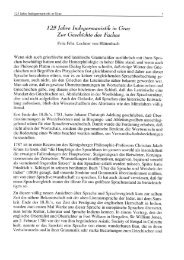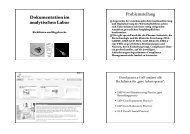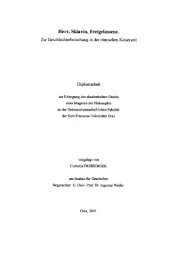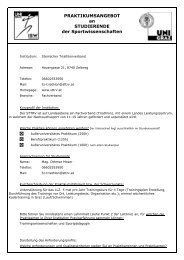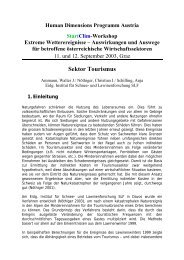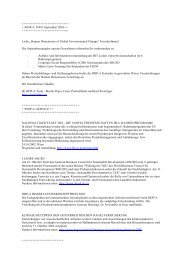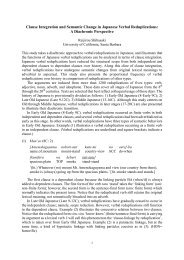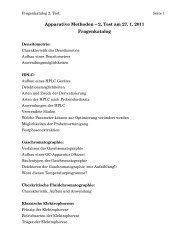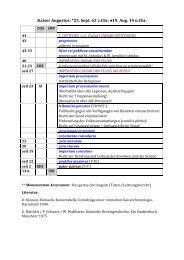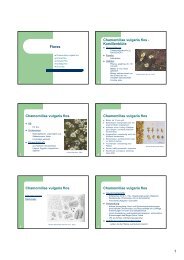Lichenicolous Biota (Nos 1–20) - Karl-Franzens-Universität Graz
Lichenicolous Biota (Nos 1–20) - Karl-Franzens-Universität Graz
Lichenicolous Biota (Nos 1–20) - Karl-Franzens-Universität Graz
You also want an ePaper? Increase the reach of your titles
YUMPU automatically turns print PDFs into web optimized ePapers that Google loves.
- 35 -<br />
<strong>Lichenicolous</strong> <strong>Biota</strong> (<strong>Nos</strong> <strong>1–20</strong>)<br />
Josef HAFELLNER*<br />
HAFELLNER J. 2007: <strong>Lichenicolous</strong> <strong>Biota</strong> (<strong>Nos</strong> <strong>1–20</strong>). – Fritschiana<br />
(<strong>Graz</strong>) 60: 35–49. - ISSN 1024-0306.<br />
Abstract: The first fascicle (20 numbers) of the new exsiccata<br />
“<strong>Lichenicolous</strong> <strong>Biota</strong>” is published. The issue contains material<br />
of one lichenized and 18 non-lichenized fungal taxa (14 ascomycetes,<br />
1 basidiomycete, 4 anamorphic fungi), including isotype<br />
material (no 9) and paratype material (no 20) of Taeniolella<br />
atricerebrina Hafellner.<br />
Zusammenfassung: Der erste Faszikel (20 Nummern) eines<br />
neuen Exsikkates namens „<strong>Lichenicolous</strong> <strong>Biota</strong>“ wird veröffentlicht.<br />
Die Ausgabe enthält Proben von einem lichenisierten und<br />
18 nicht-lichenisierten Taxa (14 Ascomyceten, 1 Basidiomycet,<br />
4 anamorphe Pilze), einschließlich Isotypen (no. 9) und Dubletten<br />
eines Paratypus (no. 20) von Taeniolella atricerebrina Hafellner.<br />
*Institut für Pflanzenwissenschaften, <strong>Karl</strong>-<strong>Franzens</strong>-<strong>Universität</strong>, Holteigasse 6,<br />
A-8010 <strong>Graz</strong>, AUSTRIA, e-mail: josef.hafellner@uni-graz.at<br />
Introduction<br />
<strong>Lichenicolous</strong> biota, especially fungi, have attracted considerable interest<br />
since about 40 years, and a number of scientists devoted much of their efforts<br />
to studying such organisms.<br />
One possible way to promote these interests is the distribution of an<br />
exsiccata. Prof. Rolf Santesson (Uppsala, Sweden) has been the first and so far<br />
only editor of an exsiccata restricted to lichenicolous fungi (starting with<br />
SANTESSON, R. 1984. Fungi lichenicoli exsiccati. Fasc. I–II (No 1–50). Publications<br />
from the Herbarium, University of Uppsala, 13: <strong>1–20</strong>). So far, 350<br />
numbers have been distributed, and we all are very grateful to Prof. Santesson<br />
for this initiative. My colleagues and I have found this exsiccata most useful,<br />
and some of us are privileged in having easy access to it. For Santesson’s<br />
exsiccata, at least 10 duplicates were necessary, a number of specimens,<br />
which is not always easy to obtain from a single collection. Therefore I<br />
accumulated collections of lichenicolous taxa with at least 5 but less than 10<br />
duplicates over the years, and I now decided to distribute this material in a new<br />
exsiccata named “<strong>Lichenicolous</strong> <strong>Biota</strong>”, which is offered to several institutions<br />
on exchange basis.<br />
As for all exsiccata, the aims are: to share knowledge about a particular<br />
group of organisms with colleagues, to make species concepts available and<br />
easier to check on the basis of a real specimen, to distribute the material of
- 36 -<br />
even rather common taxa from various localities in order to facilitate comparative<br />
studies among populations, and to deposit rich collections in a useful<br />
manner.<br />
Contrary to Santesson's 'Fungi lichenicoli exsiccati', the present exsiccata<br />
will cover all lichenicolous biota. One may assume that the majority will still be<br />
non-lichenized and lichenized fungi, but the exsiccata is also open to myxomycetes,<br />
bacteria, and even animals, whenever they cause a characteristic<br />
symptom on their host (e.g., discoloration or galls). Consequently, the exsiccata<br />
will contain both highly host-specific and plurivorous species, as long as the<br />
individuals clearly grow upon a lichen and the collection is homogeneous, so<br />
that identical duplicates can be prepared.<br />
As the exsiccata will mainly contain fungi, I decided to distribute the sets<br />
primarily to institutions housing large collections of lichenized and nonlichenized<br />
fungi, including a representative stock of lichenicolous taxa. On the<br />
other hand, I want to spread out the material geographically. Therefore I<br />
decided to send the five complete sets to herbaria of the following regions:<br />
Central Europe (<strong>Graz</strong> [GZU]), Northern Europe (Uppsala [UPS]), Western<br />
Europe (Bruxelles [BR]), North America (New York [NY]), Australasia (Canberra<br />
[CANB]). Incomplete sets will preferably be distributed to institutions where at<br />
least one active researcher interested in lichenicolous fungi is affiliated, e.g., to<br />
Barcelona [BCC], Edinburgh [E], Leningrad [LE], Munich [M], and Prague [PRM]<br />
(herbarium acronyms sec. HOLMGREN & HOLMGREN 1998, onwards: Index<br />
Herbariorum. New York Botanical Garden. http://sciweb.nybg.org/science2/<br />
IndexHerbariorum.asp). It is planned to publish at least one fascicle per year,<br />
consisting of a variable number of decades.<br />
I would be very grateful to receive material of lichenicolous biota from my<br />
colleagues. The collections should be divided up into at least 5 (up to 10)<br />
duplicates, preferably already prepared. Unprepared collections should be rich<br />
enough to obtain at least 5 duplicates.<br />
For the first issue, I gratefully acknowledge the contribution of one collection<br />
by Javier Etayo and one by Walter Obermayer, and the help during fieldwork by<br />
Angela Hafellner, Jolanta Miadlikowska, Lucia Muggia, Pier Luigi Nimis, Mauro<br />
Tretiach, and Mikhail Zhurbenko. Christian Scheuer, Walter Obermayer, and<br />
Helmut Mayrhofer are thanked for critically reading the manuscript.
- 37 -<br />
Hafellner J. 2007: <strong>Lichenicolous</strong> <strong>Biota</strong> (<strong>Nos</strong> <strong>1–20</strong>). - Fritschiana 60: 35–49.<br />
1. Biatoropsis usnearum Räsänen<br />
in Ann. Soc. Zool. Bot. Fenn. Vanamo 5(9): 8 (1934).<br />
Host: Usnea articulata (thallus)<br />
Africa, Canary Islands: Gran Canaria, along the road from Moya to Artenara,<br />
between Las Fontanales and the lookout point Los Pinos de Galdar, c. 1350 m<br />
alt., 28°02'20"N / 15°37'W; open pine forest, on branches of Pinus canariensis.<br />
Note: The type host of Biatoropsis usnearum is Usnea comosa (syn. U. subfloridana). In the<br />
protologue three species are mentioned (U. glabrescens, U. comosa, U. similis). Diederich &<br />
Christiansen (Lichenologist 26: 49, 1994) have chosen a lectotype, the host of which is named<br />
U. comosa.<br />
21. II. 1994 leg. J. Hafellner (53831) & A. Hafellner, det J. Hafellner<br />
distributed to: BCC, BR, CANB, E, GZU, LE, M, NY, PRM, UPS<br />
Hafellner J. 2007: <strong>Lichenicolous</strong> <strong>Biota</strong> (<strong>Nos</strong> <strong>1–20</strong>). - Fritschiana 60: 35–49.<br />
2. Catillaria mediterranea Hafellner<br />
in Herzogia 6: 293 (1982). – Bas.: Scutula pleiospora Vouaux in Pitard & Harmand, Bull. Soc.<br />
Bot. France 58, Mem. 22: 72 (1911), non Catillaria pleiospora (J.Steiner) J.Steiner (1898).<br />
Host: Ramalina bourgeana (thallus)<br />
Africa, Canary Islands: Gran Canaria, high above the west coast by the road<br />
from San Nicolás to Agaete, Andén Verde, c. 530 m alt., 28°01'30"N / 15°46'W;<br />
volcanic cliffs, on steep rock faces exposed to the W.<br />
Note: Ramalina bourgeana is the type host of the species.<br />
20. II. 1994 leg. J. Hafellner (41056) & A. Hafellner, det. J. Hafellner<br />
distributed to: BCC, BR, CANB, E, GZU, LE, M, NY, PRM, UPS
- 38 -<br />
Hafellner J. 2007: <strong>Lichenicolous</strong> <strong>Biota</strong> (<strong>Nos</strong> <strong>1–20</strong>). - Fritschiana 60: 35–49.<br />
3. Endococcus macrosporus (Hepp ex Arnold) Nyl.<br />
in Lamy, Bull. Soc. Bot. France 25: 504 (1878). – Bas.: Tichothecium macrosporum Hepp ex<br />
Arnold in Verh. K. K. Zool.-Bot. Ges. Wien 18: 960 (1868).<br />
Host: Rhizocarpon geographicum (thallus)<br />
Europe, Austria: Styria, Eastern Alps, Niedere Tauern, Triebener Tauern,<br />
Griesmoar Kogel SW of the village Wald am Schoberpaß, ridge exposed to the<br />
N above the saddle to Himmeleck, 47°25’15’’N / 14°36’10’’E, c. 1950 m alt., GF<br />
8553/4; low outcrops of mica schist in alpine vegetation.<br />
Note: The type host of Endococcus macrosporus is Rhizocarpon alpicola.<br />
20. VIII. 2002 leg. J. Hafellner (58888) & J. Miadlikowksa, det. J. Hafellner<br />
distributed to: BR, CANB, GZU, LE, M, NY, UPS<br />
Hafellner J. 2007: <strong>Lichenicolous</strong> <strong>Biota</strong> (<strong>Nos</strong> <strong>1–20</strong>). - Fritschiana 60: 35–49.<br />
4. Lichenochora obscuroides (Linds.) Triebel & Rambold<br />
in Rambold & Triebel, Biblioth. Lichenol. 48: 168 (1992). – Bas.: Lecidea obscuroides Linds. in<br />
Trans. Roy. Soc. Edinburgh 22: 112, 247 (1859). – Syn.: Lichenochora thallina (Cooke)<br />
Hafellner in Nova Hedwigia 48: 363 (1989).<br />
Host: Phaeophyscia orbicularis (thallus)<br />
Europe, Austria: Styria, Oststeirisches Hügelland, <strong>Graz</strong>, Ragnitztal E of the<br />
town, Dr. Hanisch-Weg, 47°04’35’’N / 15°28’50’’E, c. 380 m alt., GF 8958/2; old<br />
orchard, on canopy branches of Juglans regia.<br />
Note: Phaeophyscia orbicularis is the type host of the species. The thalli are partly also infested<br />
by Arthonia phaeophysciae Grube & Matzer (e.g., the specimen in GZU).<br />
8. IX. 2006 leg. et det. J. Hafellner (67536)<br />
distributed to: BCC, BR, CANB, E, GZU, LE, M, NY, PRM, UPS
- 39 -<br />
Hafellner J. 2007: <strong>Lichenicolous</strong> <strong>Biota</strong> (<strong>Nos</strong> <strong>1–20</strong>). - Fritschiana 60: 35–49.<br />
5. Nigropuncta rugulosa D.Hawksw.<br />
in Bull. Brit. Mus. (Nat. Hist.), Bot. 9(1): 46 (1981).<br />
Host: Bellemerea cinereorufescens (thallus)<br />
Europe, Austria: Styria, Eastern Alps, Gurktaler Alpen, surroundings of the<br />
pass Turracherhöhe, hill N above the lake Turrachsee, ENE above the hotel<br />
Seewirt, 46°55’30’’N / 13°52’40’’E, c. 1850 m alt., GF 9049/3; open forest with<br />
codominant Picea abies, Larix decidua, and Pinus cembra, in overhangs of<br />
boulders and outcrops of a Palaeozoic conglomerate.<br />
Note: Bellemerea cinereorufescens is the type host of Nigropuncta rugulosa (isotype in GZU).<br />
However, the host had remained undetermined when the lichenicolous fungus was described,<br />
because the infection strongly suppresses the formation of host apothecia.<br />
27. VII. 2002 leg. et det. J. Hafellner (61656)<br />
distributed to: BCC, BR, CANB, GZU, LE, M, NY, UPS<br />
Hafellner J. 2007: <strong>Lichenicolous</strong> <strong>Biota</strong> (<strong>Nos</strong> <strong>1–20</strong>). - Fritschiana 60: 35–49.<br />
6. Paranectria oropensis (Ces.) D.Hawksw. & Piroz.<br />
in Can. J. Bot. 55: 2555 (1977). – Bas.: Sphaeria oropensis Ces. in Rabenh., Bot. Zeitung 15:<br />
406 (1857).<br />
Host: sterile corticolous crustose lichen (thallus)<br />
Europe, Austria: Styria, Oststeirisches Hügelland, 7 km E of the centre of<br />
<strong>Graz</strong>, 2.9 km SW of Hönigtal, forested area between Ragnitzstraße and Höhenstraße,<br />
47°04’45’’N / 15°31’45’’E, 460–480 m alt., GF 8959/1, mixed lowland<br />
forest with Fagus sylvatica, Pinus sylvestris, and Picea abies, on bark of<br />
Carpinus betulus.<br />
Note: The type host of Paranectria oropensis are sterile squamules of a so far undetermined<br />
lichen.<br />
25. IX. 2006 leg. W. Obermayer (11358), det. J. Hafellner<br />
distributed to: BCC, BR, CANB, E, GZU, LE, M, NY, PRM, UPS
- 40 -<br />
Hafellner J. 2007: <strong>Lichenicolous</strong> <strong>Biota</strong> (<strong>Nos</strong> <strong>1–20</strong>). - Fritschiana 60: 35–49.<br />
in Ann. Sci. Nat., Bot., sér. 3, 17: 126 (1852).<br />
7. Phacopsis vulpina Tul.<br />
Host: Letharia vulpina (thallus)<br />
Europe, Austria: Styria, Eastern Alps, Niedere Tauern, Triebener Tauern,<br />
Gamskögel SW above the refuge Mödringhütte, on slopes exposed to the N,<br />
47°22’25’’N / 14°33’20’’E, c. 1700 m alt., GF 8653/1; subalpine forest with Larix<br />
decidua and Picea abies, on bark of Larix decidua.<br />
Note: Letharia vulpina is the type host of the species.<br />
1. V. 2006 leg. J. Hafellner (65963), L. Muggia & A. Hafellner, det. J. Hafellner<br />
distributed to: BCC, BR, CANB, GZU, LE, M, NY, UPS<br />
Hafellner J. 2007: <strong>Lichenicolous</strong> <strong>Biota</strong> (<strong>Nos</strong> <strong>1–20</strong>). - Fritschiana 60: 35–49.<br />
in Herzogia 9: 760 (1993).<br />
8. Sphaerellothecium minutum Hafellner<br />
Host: Sphaerophorus fragilis (thallus)<br />
Europe, Austria: Styria, Eastern Alps, Niedere Tauern, Wölzer Tauern, mountains<br />
c. 8,5 km WNW of the village Pusterwald, Großhansl, close to the summit,<br />
47°19’10’’N / 14°15’55’’E, c. 2300 m alt., GF 8651/4; cliffs of metal-rich siliceous<br />
rock on steep slope exposed to the E, on inclined rock faces.<br />
Note: Sphaerophorus fragilis is the type host of the species.<br />
25. VIII. 2005 leg. J. Hafellner (68069), L. Muggia & A. Hafellner, det. J. Hafellner<br />
distributed to: BR, CANB, GZU, LE, M, NY, UPS
- 41 -<br />
Hafellner J. 2007: <strong>Lichenicolous</strong> <strong>Biota</strong> (<strong>Nos</strong> <strong>1–20</strong>). - Fritschiana 60: 35–49.<br />
9. Taeniolella atricerebrina Hafellner Isotype<br />
in Biblioth. Lichenol. 96: 115 (2007).<br />
Host: Tephromela atra (thallus)<br />
Europe, Austria: Styria, Eastern Alps, Niedere Tauern, Triebener Tauern,<br />
Griesmoar Kogel SW of the village Wald am Schoberpaß, ridge exposed to the<br />
N above the saddle to Himmeleck, 47°25’15’’N / 14°36’10’’E, c. 1950 m alt., GF<br />
8553/4; low outcrops of mica schist in alpine vegetation.<br />
Note: The infection of Tephromela atra with Taeniolella atricerebrina induces the formation of<br />
conspicuous galls.<br />
20. VIII. 2002 leg. J. Hafellner (59165) & J. Miadlikowska, det. J. Hafellner<br />
distributed to: BR, CANB, E, GZU, NY, UPS<br />
Hafellner J. 2007: <strong>Lichenicolous</strong> <strong>Biota</strong> (<strong>Nos</strong> <strong>1–20</strong>). - Fritschiana 60: 35–49.<br />
10. Telogalla olivieri (Vouaux) Nik.Hoffm. & Hafellner<br />
in Biblioth. Lichenol. 77: 109 (2000). – Bas.: Laestadia olivieri Vouaux in Bull. Soc. Mycol.<br />
France 28: 216 (1912) nomen novum for Verrucaria xanthoriae Wedd. f. megaspora H.Olivier in<br />
Princ. Paras. Lich. Fr. Suppl. 1: 14 (1907).<br />
Host: Xanthoria parietina (thallus)<br />
Europe, Austria: Styria, Eastern Alps, Nördliche Kalkalpen, Hochschwab-<br />
Gruppe, Seetal W of the village Seewiesen, c. 10 km NE of Aflenz, 47°37’15’’N /<br />
15°15’20’’E, c. 930 m alt., GF 8357/4; row of trees along the edge of a meadow,<br />
on lower canopy branches of Fraxinus excelsior<br />
Note: Xanthoria parietina is the type host of the species.<br />
18. XI. 2007 leg. et det. J. Hafellner (69273)<br />
distributed to: BCC, BR, CANB, E, GZU, LE, M, NY, PRM, UPS
- 42 -<br />
Hafellner J. 2007: <strong>Lichenicolous</strong> <strong>Biota</strong> (<strong>Nos</strong> <strong>1–20</strong>). - Fritschiana 60: 35–49.<br />
in Linzer Biol. Beitr. 31: 508 (1999).<br />
11. Arthonia digitatae Hafellner<br />
Host: Cladonia digitata (thallus squamules)<br />
Europe, Austria: Styria, Eastern Alps, Steirisches Randgebirge, Stubalpe,<br />
Größenberg S of Zeltweg, NW ridge towards the village Eppenstein, Pichlmoarkogel,<br />
between Griesmoarhütte and the mountain top, on slope exposed to<br />
the SW, 47°06’05’’N / 14°46’05’’E, c. 1560 m alt., GF 8854/4; montane forest<br />
with Larix decidua and Picea abies, on rotten stumps.<br />
Note: Cladonia digitata is the type host of the species.<br />
18. VIII. 2005 leg. et det. J. Hafellner (65869)<br />
distributed to: BR, CANB, GZU, NY, UPS<br />
Hafellner J. 2007: <strong>Lichenicolous</strong> <strong>Biota</strong> (<strong>Nos</strong> <strong>1–20</strong>). - Fritschiana 60: 35–49.<br />
12. Carbonea herteliana Hafellner & Matzer<br />
in Hafellner, Linzer Biol. Beitr. 31: 509 (1999).<br />
Host: Rhizocarpon umbilicatum (thallus)<br />
Europe, Austria: Styria, Eastern Alps, Nördliche Kalkalpen, Ennstaler Alpen,<br />
Gesäuseberge SE of Admont, knoll between the mountains Riffel and Kalbling,<br />
47°33’05’’N / 14°31’05’’E, c. 2000 m, GF 8453/1; outcrops of Triassic limestone<br />
in alpine meadows, on inclined rock faces of outcrops.<br />
Note: Rhizocarpon umbilicatum is the type host of the species.<br />
13. IX. 2006 leg. et det. J. Hafellner (67789)<br />
distributed to: BR, CANB, GZU, NY, UPS
- 43 -<br />
Hafellner J. 2007: <strong>Lichenicolous</strong> <strong>Biota</strong> (<strong>Nos</strong> <strong>1–20</strong>). - Fritschiana 60: 35–49.<br />
13. Carbonea intrudens (H.Magn.) Hafellner<br />
in Fritschiana 52: 40 (2006). – Bas.: Lecidea intrudens H.Magn. in Ark. Bot. 33A(1): 53 (1946).<br />
Host: Rhizocarpon geographicum (thallus)<br />
Europe, Italy: Piemonte, Cuneo, Western Alps, Alpi Cozie, crest SW above<br />
Colle dell' Agnello, 44°40’55’’N / 06°58’35’’E, c. 2830 m; outcrops of calcareous<br />
schist on steep slope exposed to the SE, on banks of schist partly rich in<br />
calcium.<br />
Note: Rhizocarpon geographicum is the type host of the species.<br />
25. VII. 2000 leg. et det. J. Hafellner (60264)<br />
(together with M. Tretiach and P. L. Nimis)<br />
distributed to: BR, CANB, GZU, NY, UPS<br />
Hafellner J. 2007: <strong>Lichenicolous</strong> <strong>Biota</strong> (<strong>Nos</strong> <strong>1–20</strong>). - Fritschiana 60: 35–49.<br />
14. Cercidospora crozalsiana (H.Olivier) Nav.-Ros., Cl.Roux &<br />
Casares<br />
in Cryptogamie, Bryol.-Lichénol. 16: 100 (1995). – Bas.: Sphaeria crozalsiana H.Olivier in Bull.<br />
Acad. Int. Géogr. Bot. 17: 168 (1907).<br />
Host: Squamarina cartilaginea (thallus)<br />
Europe, Spain: Aragón, Zaragoza, La Retverta, Pina de Ebro c. 35 km SE of<br />
Zaragoza, UTM 30TYL29-97, c. 200 m alt., on gypsum soil.<br />
Note: The type host of the species is Squamarina lentigera.<br />
11. III. 1991 leg. et det. J. Etayo<br />
distributed to: BR, CANB, GZU, NY, UPS
- 44 -<br />
Hafellner J. 2007: <strong>Lichenicolous</strong> <strong>Biota</strong> (<strong>Nos</strong> <strong>1–20</strong>). - Fritschiana 60: 35–49.<br />
15. Illosporiopsis christiansenii (B.L.Brady & D.Hawksw.)<br />
D.Hawksw.<br />
in Sikaroodi et al., Mycol. Res. 105: 457 (2001). – Bas.: Hobsonia christiansenii B.L.Brady &<br />
D.Hawksw. in Lowen et al., Mycologia 78: 842 (1986).<br />
Host: Physcia adscendens (thallus)<br />
Europe, Austria: Styria, Eastern Alps, Steirisches Randgebirge, Fischbacher<br />
Alpen, on the saddle between the mountains Ederkogel and Aibel, NE of the<br />
village St. Jakob bei Mixnitz, 47°25’00’’N / 15°27’50’’E, c. 1100 m alt., GF<br />
8558/4; row of trees along the edge of a pasture, on bark of Fraxinus excelsior.<br />
Note: The type host of the species is Candelaria concolor.<br />
29. IX. 1999 leg. et det. J. Hafellner (59545)<br />
distributed to: BR, CANB, GZU, NY, UPS<br />
Hafellner J. 2007: <strong>Lichenicolous</strong> <strong>Biota</strong> (<strong>Nos</strong> <strong>1–20</strong>). - Fritschiana 60: 35–49.<br />
16. Lichenoconium lecanorae (Jaap) D.Hawksw.<br />
in Bull. Brit. Mus. (Nat. Hist.), Bot. 6(3): 270 (1979). – Bas.: Coniosporium lecanorae Jaap in<br />
Lindau, Verh. Bot. Vereins Prov. Brandenburg 47: 71 (1906).<br />
Host: Lecanora saligna (hymenia)<br />
Europe, Austria: Styria, Eastern Alps, Nördliche Kalkalpen, Hochschwab<br />
group, massif of Meßnerin c. 25 km NW of the town Kapfenberg, Rabenstein S<br />
above the inn Bodenbauer, 47°34’15’’N / 15°06’35’’E, c. 1480 m alt., GF 8456/2;<br />
forest with Picea abies and Larix decidua, on slope exposed to the E, on wood<br />
of snags.<br />
Note: The type host of the species is Lecanora chlarotera.<br />
4. VII. 2004 leg. et det. J. Hafellner (63723)<br />
distributed to: BR, CANB, GZU, NY, UPS
- 45 -<br />
Hafellner J. 2007: <strong>Lichenicolous</strong> <strong>Biota</strong> (<strong>Nos</strong> <strong>1–20</strong>). - Fritschiana 60: 35–49.<br />
17. Skyttea nitschkei (Körb.) Sherwood, D.Hawksw. & Coppins<br />
in Trans. Brit. Mycol. Soc. 75: 488 (1981, “1980”). – Bas.: Nesolechia nitschkei Körb. in Parerga<br />
Lichenol.: 462 (1865).<br />
Host: Thelotrema lepadinum (thallus, apothecial margins)<br />
Europe, Austria: Styria, Eastern Alps, Ennstaler Alpen, Gesäuse, in the valley<br />
Hartelsgraben c. 3 km W of the village Hieflau, somewhat before the second<br />
bridge over the creek, 47°35’15’’N / 14°42’25’’E, c. 660 m alt., GF 8454/1;<br />
montane forest with Fagus sylvatica, Abies alba, and Picea abies, on bark of<br />
Fagus sylvatica.<br />
Note: Thelotrema lepadinum is the type host of the species.<br />
26. VIII. 2002 leg. J. Hafellner (60630) & J. Miadlikowska, det. J. Hafellner<br />
distributed to: BR, CANB, GZU, NY, UPS<br />
Hafellner J. 2007: <strong>Lichenicolous</strong> <strong>Biota</strong> (<strong>Nos</strong> <strong>1–20</strong>). - Fritschiana 60: 35–49.<br />
18. Stigmidium congestum (Körb.) Triebel<br />
in Triebel et al., Mycotaxon 42: 290 (1991). – Bas.: Pharcidia congesta Körb. in Parerga<br />
Lichenologica: 470 (1865).<br />
Host: Lecanora chlarotera (hymenia)<br />
Europe, Austria: Styria, Eastern Alps, Steirisches Randgebirge, Stubalpe,<br />
Teigitsch-Graben NW of the village Hirschegg, c. 1 km NW of the inn<br />
Spengerwirt, 47°02’40’’N / 14°55’20’’E, c. 990 m alt., GF 8955/4; row of trees<br />
along the brook side, on bark of Alnus incana.<br />
Note: Lecanora chlarotera (f. rugosella) is the type host of the species.<br />
29. X. 2006 leg. et det. J. Hafellner (66896)<br />
distributed to: BR, CANB, GZU, NY, UPS
- 46 -<br />
Hafellner J. 2007: <strong>Lichenicolous</strong> <strong>Biota</strong> (<strong>Nos</strong> <strong>1–20</strong>). - Fritschiana 60: 35–49.<br />
19. Stigmidium pumilum (Lettau) Matzer & Hafellner<br />
in Biblioth. Lichenol. 37: 115 (1990). – Bas.: Rosellinia pumila Lettau, Repert. Spec. Nov. Regni<br />
Veg. 61(2): 150 (1958).<br />
Host: Physcia caesia (thallus)<br />
Europe, Austria: Styria, Eastern Alps, Steirisches Randgebirge, Stubalpe W of<br />
the town Köflach, SW ridge of the Rappoldkogel N above the pass Hirschegger<br />
Sattel, 47°04’35’’N / 14°52’40’’E, c. 1660 m alt., GF 8955/1, low outcrops of<br />
marble in a pasture field surrounded by subalpine Picea abies forest, on<br />
inclined rock faces, partly over saxicolous bryophytes.<br />
Note: Physcia caesia is the type host of the species.<br />
18. VIII. 2006 leg. et det. J. Hafellner (66699)<br />
distributed to: BR, CANB, GZU, NY, UPS<br />
Hafellner J. 2007: <strong>Lichenicolous</strong> <strong>Biota</strong> (<strong>Nos</strong> <strong>1–20</strong>). - Fritschiana 60: 35–49.<br />
20. Taeniolella atricerebrina Hafellner Paratype material<br />
in Biblioth. Lichenol. 96: 115 (2007).<br />
Host: Tephromela atra (thallus)<br />
Europe, Austria: Styria, Eastern Alps, Niedere Tauern, Seckauer Tauern,<br />
Hämmerkogel N of the village Seckau, above the small lake Goldlacke, on<br />
slopes exposed to the S, c. 2100 m alt.; 47°20’30’’N / 14°45’05’’E; GF 8654/4;<br />
low outcrops of siliceous rocks in alpine meadows, on inclined rock faces.<br />
Note: Tephromela atra is the type host of the species. Isotypes of Taeniolella atricerebrina have<br />
been distributed as “<strong>Lichenicolous</strong> <strong>Biota</strong> no. 9”.<br />
20. X. 2001 leg. et det. J. Hafellner (64099)<br />
distributed to: BR, CANB, GZU, NY, UPS
- 47 -<br />
Taxon Synopsis:<br />
Taxon<br />
Ascomycota<br />
Exs. no.<br />
Lecanoromycetes (incl. Ostropales)<br />
Carbonea herteliana............................................................................................ 12<br />
Carbonea intrudens............................................................................................. 13<br />
Catillaria mediterranea .......................................................................................... 2<br />
Phacopsis vulpina ................................................................................................. 7<br />
Skyttea nitschkei ................................................................................................. 17<br />
Arthoniomycetes<br />
Arthonia digitatae ................................................................................................ 11<br />
Leotiomycetes<br />
Sordariomycetes (incl. Hypocreales, Sordariales)<br />
Lichenochora obscuroides .................................................................................... 4<br />
Paranectria oropensis ........................................................................................... 6<br />
Eurotiomycetes (incl. Verrucariales)<br />
Endococcus macrosporus ..................................................................................... 3<br />
Telogalla olivieri................................................................................................... 10<br />
Dothideomycetes<br />
Cercidospora crozalsiana.................................................................................... 14<br />
Sphaerellothecium minutum.................................................................................. 8<br />
Stigmidium congestum ........................................................................................ 18<br />
Stigmidium pumilum ............................................................................................ 19<br />
Anamorphic Fungi<br />
Hyphomycetes<br />
Illosporiopsis christiansenii.................................................................................. 15<br />
Taeniolella atricerebrina .................................................................................. 9, 20<br />
Coelomycetes<br />
Lichenoconium lecanorae ................................................................................... 16<br />
Nigropuncta rugulosa ............................................................................................ 5<br />
Basidiomycota<br />
Homobasidiomycetes<br />
Heterobasidiomycetes<br />
Biatoropsis usnearum............................................................................................ 1
- 48 -<br />
Host Index:<br />
Host taxon <strong>Lichenicolous</strong> taxon Exs. no.<br />
Bellemerea cinereorufescens ........Nigropuncta rugulosa.............................................. 5<br />
Cladonia digitata............................Arthonia digitatae .................................................. 11<br />
Lecanora chlarotera.......................Stigmidium congestum.......................................... 18<br />
Lecanora saligna ...........................Lichenoconium lecanorae ..................................... 16<br />
Letharia vulpina .............................Phacopsis vulpina ................................................... 7<br />
Phaeophyscia orbicularis...............Lichenochora obscuroides ...................................... 4<br />
Physcia adscendens......................Illosporiopsis christiansenii ................................... 15<br />
Physcia caesia...............................Stigmidium pumilum.............................................. 19<br />
Ramalina bourgeana .....................Catillaria mediterranea ............................................ 2<br />
Rhizocarpon geographicum...........Carbonea intrudens............................................... 13<br />
Rhizocarpon geographicum...........Endococcus macrosporus....................................... 3<br />
Rhizocarpon umbilicatum ..............Carbonea herteliana.............................................. 12<br />
Sphaerophorus fragilis...................Sphaerellothecium minutum.................................... 8<br />
Squamarina cartilaginea................Cercidospora crozalsiana...................................... 14<br />
Tephromela atra ............................Taeniolella atricerebrina.................................... 9, 20<br />
Thelotrema lepadinum...................Skyttea nitschkei ................................................... 17<br />
Usnea articulata.............................Biatoropsis usnearum ............................................. 1<br />
Xanthoria parietina.........................Telogalla olivieri .................................................... 10<br />
sterile crustose lichen ....................Paranectria oropensis ............................................. 6
- 49 -<br />
Geographic Index:<br />
BIOGEOGRAPHIC UNITS*<br />
Country<br />
(or Archipelago) <strong>Lichenicolous</strong> taxon Exs. no.<br />
1. EUROPE<br />
Austria<br />
Arthonia digitatae..................................................................... 11<br />
Carbonea herteliana ................................................................ 12<br />
Endococcus macrosporus ......................................................... 3<br />
Illosporiopsis christiansenii ...................................................... 15<br />
Lichenochora obscuroides......................................................... 4<br />
Lichenoconium lecanorae........................................................ 16<br />
Nigropuncta rugulosa ................................................................ 5<br />
Paranectria oropensis................................................................ 6<br />
Phacopsis vulpina...................................................................... 7<br />
Skyttea nitschkei...................................................................... 17<br />
Sphaerellothecium minutum ...................................................... 8<br />
Stigmidium congestum ............................................................ 18<br />
Stigmidium pumilum ................................................................ 19<br />
Taeniolella atricerebrina ...................................................... 9, 20<br />
Telogalla olivieri....................................................................... 10<br />
Italy<br />
Carbonea intrudens ................................................................. 13<br />
Spain (see also Africa, Canary Islands)<br />
Cercidospora crozalsiana ........................................................ 14<br />
2. AFRICA<br />
Canary Islands<br />
Biatoropsis usnearum................................................................ 1<br />
Catillaria mediterranea .............................................................. 2<br />
3. ASIA TEMPERATE<br />
4. ASIA TROPICAL<br />
5. AUSTRALASIA<br />
6. PACIFIC<br />
7. NORTHERN AMERICA<br />
8. SOUTHERN AMERICA<br />
9. ANTARCTIC<br />
* The nomenclature of the biogeographic units follows BRUMMITT, R.K. 2001: World Geographical<br />
Scheme for Recording Plant Distributions. Edition 2. - Pittsburg: Hunt Institute for Botanical<br />
Documentation Carnegie Mellon University.



